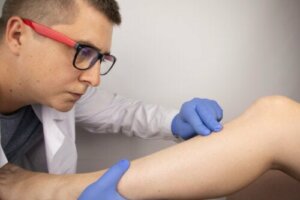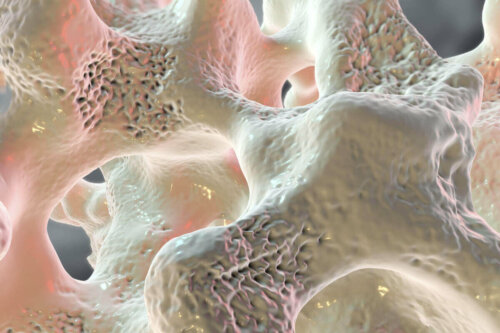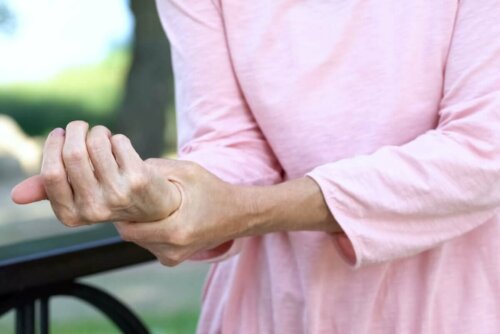Bone Contusion: Causes, Symptoms, and Treatments

Bone fractures are among the most common traumatic injuries. These are defined as when the bone completely breaks. However, there’s a similar injury called a bone contusion, which specialists define simply as a partial break of a portion of the bone.
Bones are calcified structures largely composed of two different sections: a cortical and a trabecular. The former of those is the most resistant and is on the outside, whilst the latter consists of vascularized fibrous connective tissue.
Bone contusion happens when a section of the trabecular part of the bone breaks. This generates an accumulation of blood in the area and leads to bruising. Studies show that this injury is more common in adults, however, it’s not an exceptional circumstance in children.
What are the symptoms of a bone contusion?
Skin bruises are easy to identify as they cause a change to the color of the skin from the beginning. However, when it comes to a bone contusion or swelling, it’s a little more complex to diagnose.
The most obvious symptom of this injury is feeling pain in the affected area. This pain may increase with movement and reduce with rest. In more severe cases, the pain may continue when resting and even during sleep.
Alternatively, people with bone contusions may also present the following symptoms:
- Inflammation close to the injury
- Nearby joints feeling stiff or inflamed
- Injured area feeling soft to the touch
- Change in skin color
These symptoms can last between 12 and 24 weeks. This all depends on the severity of the injury and the time it takes the individual’s body to completely heal.

Main causes
The most common cause of bone contusions is usually trauma or a strong blow to a part of the body, as is the case with fractures. The most affected areas are those wherein the bone is in close contact with the skin, such as the knee, the ankle, or the elbow.
With that in mind, we can mention sporting injuries, vehicular accidents, and falls from great heights. Alternatively, joint sprains can also cause bone swelling to appear.
Some medical conditions, such as rheumatoid arthritis can cause a bone contusion. This is because these conditions affect the bones affected by illness, which makes them more likely to suffer injury.
When should you visit a doctor?
A bone contusion can cause serious problems if it’s not treated properly. For that reason, it’s vital to visit a doctor when you suspect you may be suffering.
One of the complications of this kind of injury is osteonecrosis. This is when the swelling doesn’t properly reduce. It happens if the individual is at risk of having insufficient blood in the area of the bone, which is caused by cells dying.
Additionally, you should also see a doctor if you present any of the following symptoms after the injury:
- A large increase of the affected area
- Severe inflammation of joints close to the injury
- Inability to move the affected limb
- Intense pain that doesn’t reduce when taking painkillers
Bone contusion diagnosis
The specialist will first focus on establishing how the injury happened. They will also determine the intensity of the pain and whether you have any other symptoms.
To do this, they will ask multiple questions and carry out a complete physical exam, since the contusion may be related to other problems, like ligament ruptures.
Exact bone contusion diagnosis will be done through imaging studies, which may include an X-Ray and magnetic resonance imaging or MRI scan. X-rays don’t show if the individual has a bone contusion but they do show the general state of the bone.
MRIs focus on the bone marrow, which shows if there’s an injury. This exam allows specialists to observe the precise location, extension, and size of the swelling.
Available treatments
Bone contusions aren’t injuries that require surgical treatment as they usually heal themselves within a few months. When it comes to mild contusions, doctors will prescribe rest and using non-steroid anti-inflammatory medication to provide symptom relief.
Applying ice for 15 to 10 minutes a day can reduce inflammation of the area. However, it’s important to not apply this directly to the skin. If the contusion involves the lower extremities, it’s important to keep your leg elevated.
When it comes to severe bone contusions you should reduce the amount of weight you put on the area and use crutches if necessary. Doctors will only recommend you keep the body part still when joints or ligaments are affected.

You may also be interested in: Strengthen Your Bones and Alleviate Pain in Your Joints With This Natural Drink
Advice for preventing bone injuries
You can prevent bone contusion and other bone or joint-related illnesses by improving the general condition of your bones. Some lifestyle changes can cause a significant effect.
Among the habits and activities that contribute to maintaining your bones in a good state of health we find the following:
- Follow a balanced diet with adequate nutrients
- Exercise regularly or do sport
- Use protective equipment when it comes to practicing contact sport
- Don’t smoke and reduce your alcohol intake
Calcium is the main component in bones, which is why it’s important to guarantee your body a good supply of this mineral to allow it to correctly care for your bones. The daily recommended amount of calcium both men and women should consume is around 2/5 oz. However, studies show that at least 50% of the population doesn’t consume this amount.
A bone contusion is a problem that you should take seriously
A bone contusion may seem like a mild problem that will sort itself out. However, people often think the same about more serious complications that they don’t receive the treatment they need. Luckily, the treatment is very simple and consists of non-steroidal painkillers and regular monitoring.
Physiotherapy may be necessary in some cases where the injury is very severe and ends up affecting the individual’s ability to use their joint. However, the recovery process is relatively quick. Consequences and complications are uncommon.
All cited sources were thoroughly reviewed by our team to ensure their quality, reliability, currency, and validity. The bibliography of this article was considered reliable and of academic or scientific accuracy.
- Muñoz Ch Sara, Paolinelli G. Paola. Reacciones del hueso frente al estrés agudo: estudio radiológico. Rev. chil. radiol. 2005; 11( 2 ): 81-90.
- Bastos R, Andrade R, Vasta S, Pereira R, Papalia R, van der Merwe W, Rodeo S, Espregueira-Mendes J. Tibiofemoral bone bruise volume is not associated with meniscal injury and knee laxity in patients with anterior cruciate ligament rupture. Knee Surg Sports Traumatol Arthrosc. 2019 Oct;27(10):3318-3326.
- Filardo G, Andriolo L, di Laura Frattura G, Napoli F, Zaffagnini S, Candrian C. Bone bruise in anterior cruciate ligament rupture entails a more severe joint damage affecting joint degenerative progression. Knee Surg Sports Traumatol Arthrosc. 2019 Jan;27(1):44-59.
- Novaretti JV, Shin JJ, Albers M, Chambers MC, Cohen M, Musahl V, Fu FH. Bone Bruise Patterns in Skeletally Immature Patients With Anterior Cruciate Ligament Injury: Shock-Absorbing Function of the Physis. Am J Sports Med. 2018 Jul;46(9):2128-2132.
- Bordoni V, di Laura Frattura G, Previtali D, Tamborini S, Candrian C, Cristallo Lacalamita M, Del Grande F, Filardo G. Bone Bruise and Anterior Cruciate Ligament Tears: Presence, Distribution Pattern, and Associated Lesions in the Pediatric Population. Am J Sports Med. 2019 Nov;47(13):3181-3186.
- Beckmann J, Roth A, Niethard C, Mauch F, Best R, Maus U. Knochenmarködem und atraumatische Femurkopfnekrose : Therapie [Bone marrow edema and atraumatic necrosis of the femoral head : Therapy]. Orthopade. 2015 Sep;44(9):662-671.
This text is provided for informational purposes only and does not replace consultation with a professional. If in doubt, consult your specialist.








